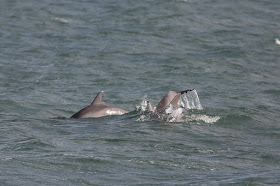This break seemed a bit far for us to reach from Oregon Inlet, but not out of the question. So we headed towards Wimble Shoals to the southeast first thing hoping to turn up a Common Murre. There was an incredible flight of Red-throated Loons in the morning and flotillas of Common Loons seemed to be popping up everywhere as we headed down Hatteras Island. Razorbills were flying, but not in the numbers we found last weekend (Kate Sutherland),
and while it took some time, we finally recruited a nice feeding flock of gulls and gannets behind the boat! Around 9:37 am a Common Murre was spotted on the water just ahead of the boat! The next thirty minutes were excellent as we found at least two more individuals on the water and Brian and I saw one more flying ahead of the boat! (Kate Sutherland)
Water temperature increased a bit as we moved offshore getting into the mid to high 40s. Bonaparte's Gulls were scattered along a tide line that also held a couple of Red Phalaropes and our first Dovekie! Right at 11:30 we saw our first Atlantic Puffin and everyone was able to get a good look at it. As a number of people were talking about our chances of Great Skua just before noon, one flew right in to the boat from the sun glare (as they often do!) and down the starboard side before it flew off to harass our gull flock! Excellent views and super exciting encounter (photo by Ed Corey).
As we continued to make our way offshore, hoping to find a temperature break, we saw a few more puffins and a couple of loggerhead turtles.
Finally, around 12:30, we hit a temperature break that was a 15 degree change! It was likely the little finger of water visible in the satellite image above just to the east of Avon. This change was full of life, a Manx Shearwater zipped by when we arrived, we found almost 50 Red Phalaropes sitting with Bonaparte's Gulls, Dovekies and puffins were out there, and the edge was teeming with hammerhead sharks! (photo by Ed Corey)
It was awesome! We had a little under an hour in this productive area, then headed back inshore where the auk show continued until around 3 in the afternoon, after which we just found Razorbills.
A pod of short-beaked common dolphins, or saddlebacks, made an energetic rush to the bow in the afternoon as well, checking us out and then moving on, riding our wake for a few minutes before they headed back offshore (Kate Sutherland).
Species List for February 23, 2020
Red Phalarope - 56
Great Skua - 1
Dovekie - 13
Common Murre - 4 to 5
Razorbill - 408
Atlantic Puffin - 13
Bonaparte's Gull - 520
Red-throated Loon - 404
Common Loon - 115
Manx Shearwater - 7
Humpback Whale - 1
Bottlenose Dolphin - about 85
Short-beaked Common Dolphin - 25-35
Loggerhead Turtle - 5
Hammerhead Shark - at least 30! (likely scalloped hammerheads)
*we also saw Herring, Lesser Black-backed, and Great Black-backed Gulls, plus Northern Gannets
The Red Phalaropes seemed to be everywhere when we got to the temperature break / color change! (Kate Sutherland)
Dovekies were not quite as cooperative as they have been on other trips this winter, but at least we had a few that showed well, just not very close. (Kate Sutherland)
Ed captured this cool image of Razorbills with the new Marc Basnight Bridge and old Bonner Bridge both in the background!
It was neat to see adult (L) and young (R) Razorbills together! (Kate Sutherland)
Atlantic Puffins were also not as cooperative as they were last weekend, but Ed captured this nice image of one!
This looked like a second winter Lesser Black-backed Gull (Kate Sutherland)
And a first winter Great Black-backed Gull (Kate Sutherland)
But as usual, the Northern Gannets were the stars behind the boat! This weekend they came in well for some nice photo ops! (Kate Sutherland)
This is the underside of an adult gannet as it enters the water - pretty interesting perspective!
But the best photos were of the darker, young gannets!
One of the large Loggerhead Turtles we saw, we also saw at least one smaller one (Kate Sutherland)
And one more artistic take on one of our hammerhead sharks! (Kate Sutherland)
We were lucky to pass right though a small feeding group of Little Tunny (Ed Corey)
































































